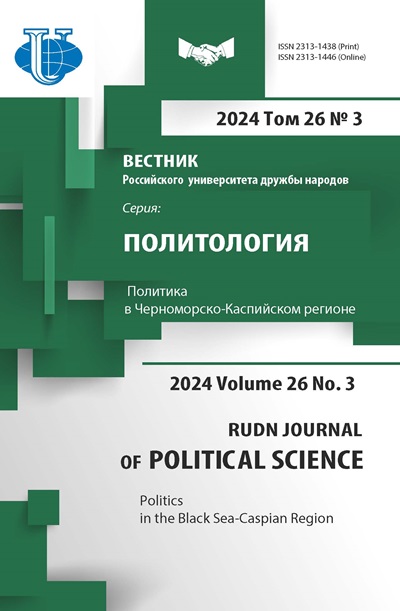CULTIVATING IMAGES OF POLITICAL FIGURES OF THE PAST IN THE MINDS OF THE BROADER POPULATION
- Authors: Belov S.I.1
-
Affiliations:
- Central Museum of the Great Patriotic War 1941-1945
- Issue: Vol 20, No 3 (2018)
- Pages: 408-416
- Section: Some actual problems of political science
- URL: https://journals.rudn.ru/political-science/article/view/19642
- DOI: https://doi.org/10.22363/2313-1438-2018-20-3-408-416
Cite item
Full Text
Abstract
The article analyzes the process of cultivating images of politicians of the past and determines its specifics as well as factors influencing the formation of the images. It concludes that the image of a politician of the past is formed mainly within the general framework of political image making. In this process, mechanisms of stereotyping, categorization and casual attribution are used. The image is created by means of visualization and verbal practices. It is formed on conscious and subconscious levels, due to which its nature is ambivalent. The image exists in the form of verbal codes and symbols and contains both rational and emotional components. Image characteristics of political figures of the past are manifested greatly through visualization. In most cases, the lack of authentic visualization of a person’s appearance causes the audience to refer to stereotypes in order to complete the image. Moreover, building the image of a historical figure is significantly less often based on the personal experience of the target audience. Finally, the image creator has access to a wider set of nominations, within which the character is positioned. This becomes possible due to the elements of national mythology, based on the archetypes of mass consciousness, and the sacred nature of the historical epic stories centered around the political figure in question.
About the authors
Sergey Igorevich Belov
Central Museum of the Great Patriotic War 1941-1945
Author for correspondence.
Email: belov2006s@yandex.ru
PhD, Scientific Secretary of Central Museum of the Great Patriotic War 1941-1945
Bratiev Fonchenko str., 10, Moscow, Russian Federation, 121170References
- Evgen'eva T.V. Istoricheskaya pamyat', natsional'noe samosoznanie i politicheskaya sotsializatsiya [Collective Memory, National Identity, and Political Socialization]. Vestnik Moskovskogo universiteta. Seriya 12: Politicheskie nauki. 2013; 1: 118—121 (In Russ.).
- Evgen'eva T.V., Selezneva A.V. Sovetskoe proshloe v tsennostnom i obrazno-simvolicheskom prostranstve rossiiskoi identichnosti [The Soviet Past in the System of Values and ImageSymbolic Space of the Russian Identity]. Polis. Politicheskie issledovaniya. 2016; 3: 25—39. (In Russ.).
- Evgen'eva T.V., Manoilo A.V., Selezneva A.V. Psikhologiya upravleniya massovym politicheskim soznaniem i povedeniem [The Psychology of Management of Mass Political Consciousness and Behavior]. Moscow: Izdatel'stvo “Izvestiya”; 2015 (In Russ.).
- Egorova-Gantman E.V. Igry v soldatiki. Politicheskaya psikhologiya prezidentov [Playing with Toy Soldiers. Political Psychology of Presidents]. Moscow: Gruppa kompanii “Nikkolo M”, 2003 (In Russ.).
- Lippman U. Obshchestvennoe mnenie [Public Opinion]. Moscow: Institut Fonda “Obshchestvennoe mnenie”; 2004 (In Russ.).
- Nesterova S.V. Vizual'nye i verbal'nye kharakteristiki obrazov vlasti. Politicheskaya psikhologiya: Khrestomatiya [Visual and Verbal Characteristics of Political Images]. Moscow: Aspekt Press; 2007. P. 401—412 (In Russ.).
- Ol'shanskii D.V. Osnovy politicheskoi psikhologii [The Basics of Political Psychology]. Ekaterinburg: Delovaya kniga; 2001 (In Russ.).
- Pankov V.V. Istoriya kak obraz i pamyat' [History as Image and Memory]. Vestnik OGU. 2006; 9: 100—105 (In Russ.).
- Pishcheva T.N. Politicheskie obrazy: problemy issledovaniya i interpretatsii [Political Images: Problems of Analysis and Interpretation]. Polis. Politicheskie issledovaniya. 2011; 2: 47—52 (In Russ.).
- Psikhologiya politicheskogo vospriyatiya v sovremennoi Rossii [The Psychology of Political Perception in Modern Russia]. Ed. by E.B. Shestopal. Moscow: Rossiiskaya politicheskaya entsiklopediya (ROSSPEN); 2012 (In Russ.).
- Samsonova T.N. Ctanovlenie grazhdanina-patriota [The Formation of a Patriotic Citizen]. Voprosy sotsial'noi teorii. 2015; Vol. 7; 1—2: 231—239 (In Russ.).
- Savel'eva I.M., Poletaev A.V. Teoriya istoricheskogo znaniya: Ucheb. posobie [The Theory of Historical Science]. SPb.: Izd-vo “Aleteiya. Istoricheskaya kniga”, 2007 (In Russ.).
- Chuev S.V. Postrevolyutsionnaya Rossiya v poiskakh natsional'nogo edinstva [Post-Revolution Russia in Search of National Solidarity]. Rostov-na-Donu: Brein; 2008 (In Russ.).
- Shestopal E.B., Akhmatnurova S.F., Bogdan I.V., Smul'kina N.V., Muzyka E.V., Nesterova S.V., Trushcheva A., Cherdantseva A.M. Istoricheskie osobennosti vospriyatiya rossiiskoi vlasti [Historical Peculiarities of Perception of Power in Russia]. Istoricheskaya psikhologiya gosudarstvennogo upravleniya. 2014; 1: 41—57 (In Russ.).
- Allport F.H. Theories of Perception and the Concept of Structure. N.Y.: Willey; 1955.
- Asch S. Social Psychology. Englewood Cliffs, NJ: Prentice-Hall; 1952.
- Bruner J., Postman L. Perception Cognition and Behavior. Journal of Personality. 1949; Vol. 18; 1: 14—31.
- Fiske S. Social Cognition and Social Perception. Annual Review of Psychology. 1993; Vol. 44: 155—194.
- Heider F. The Psychology of Interpersonal Relations. New York: John Wiley & Sons; 1958.
- Moscovici S. The Phenomenon of Social Representations. In R.S. Moscovici (Eds). Social Representations. Cambridge University: Cambridge University Press; 1984: 3—69.
- Osgood C. Psycholinguistics, Cross-Cultural Universals, and Prospects for Mankind. Westport: Praeger Publishers; 1988.
- Tajfel H., Turner J.C. The Social Identity Theory of Intergroup Behavior. S. Worchel, W.G. Austin (eds). Psychology of Intergroup Relations. 2nd ed. Chicago: Nelson-Hall; 1985: 7—24.
















